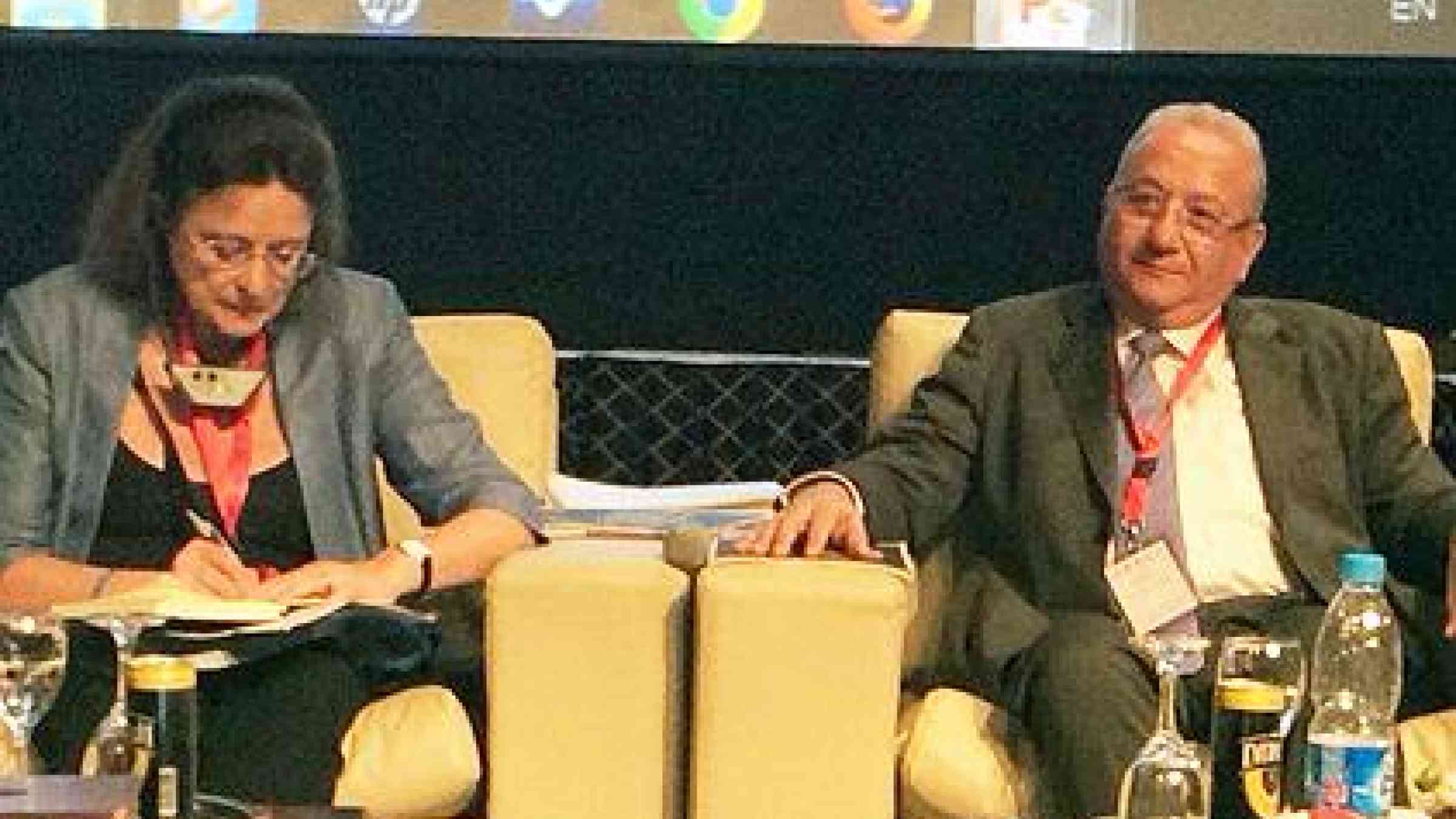Agricultural drought challenges Arab world

Prof. Virginia Murray, vice-chair, UNISDR Science and Technology Commission, and Prof. Wadid Erian, League of Arab States, spoke on the risks to the Arab region from drought and climate change. (Photo: UNISDR)
SHARM EL SHEIKH, 16 September 2014 - Agricultural drought and climate change are changing the landscape of the Arab region with enormous implications for food security, rural-urban migration and social stability, an expert told the 2nd Arab Conference on Disaster Risk Reduction yesterday.
Prof. Wadid Erian said there was a drop of 12.6% in agricultural production over the last twelve years fuelled by drought which has led to considerable losses of arable land. He highlighted that over 200 million hectares of land throughout the region are severely affected by drought and land degradation which is leading to displacement/ migration and increasing the possibility of conflict.
A senior advisor to the League of Arab States, Prof. Erian stated that over 60 million hectares of land in the region was degraded to a degree that is practically irreversible. The worst affected countries in the region in terms of percentages of land are Palestine (55%) and Djibouti (34%).
He called for the post-2015 framework for disaster risk reduction, the revision of the existing Hyogo Framework for Action (HFA), to take account of the plight of two billion people around the world living in dry lands which represent 41% of the globe.
In a day of discussion centred on the role of science and technology in disaster risk reduction, Prof. Erian called for a strong focus on recovery by capitalising on the technology and indigenous knowledge of small farmers. Better management of existing resources is an essential part of building resilience to disasters along with research, education and training.
Dr. Hammou Laamrani, adviser on climate change and water to the League of Arab States, told the conference that water scarcity was higher in the Arab world than anywhere else. Major issues are inefficient agricultural practices, land overuse, the depletion of ground water and poor use of innovation and technology. In 30 years time the gap between water demand and renewable water resources would be 51%.
There was no proper enforcement of legislation against depletion of buffer stocks of groundwater and the environmental degradation of water resources was proving to be an increasingly costly burden on GDP in many countries.
In a region where there are 100 million people short of nutritious food, Dr. Laamrani pointed out that access to food and utilization are often not given enough attention resulting in anomalies such as heavy untargeted subsidies and 30% post-harvest loss for some commodities. At the same time unhealthy diets make obesity and undernourishment/malnutrition coexist in the region.
Looking at solutions, he stressed the need to invest in communities as water, food and climate change are all local issues in terms of impact. There was a need for greater investment in science and innovation for informed policies. “Climate proofing will add a relatively small investment to overall development but will bring great benefits if done well, “ he concluded.
An evidence-based approach to the problem of agricultural drought was advocated by Dr Ayman Al-Ouda, leader of Conservation Agriculture Programme, Arab Center for the Studies of Arid Zones and Dry Lands (ACSAD), Syria.
Dr. Al-Ouda noted that 38% of farmer workers are poor and cannot access training and capacity building in agricultural extension services while also struggling against water scarcity and high fuel prices.
He called for more training of trainers (Extension workers) on Climate Adaptation techniques, weed and crop residue management, climate change adaptation tools, if farmers were to enjoy yield increases, improvement of livelihoods and better food security.
Dr. Al-Ouda’s closing message was that once farmers switch to conservation tillage, usually none revert to convention tillage.
Prof. Virgina Murray, the vice-chair of UNISDR’s Science and Technology Commission said the evidence indicates Increasing certainty about the negative impact of climate change on agriculture and crop yields.
Prof. Murray who is also a contributing author to the climate change reports of the Inter-Governmental Panel on Climate Change, said that additional stress is expected on food security systems due to the socio-economic impacts of climate change. The links of human displacement, violent conflict and indirect socio-political stability to climate change are well recognized.
The gravity of the situation underlined the importance of gaining support for an international science advisory mechanism for disaster risk reduction to strengthen resilience for the post-2015 agenda and to promote an evidence and knowledge based approach to disaster risk reduction and climate change adaptation.
Explore further
Also featured on
Is this page useful?
Yes No Report an issue on this pageThank you. If you have 2 minutes, we would benefit from additional feedback (link opens in a new window).